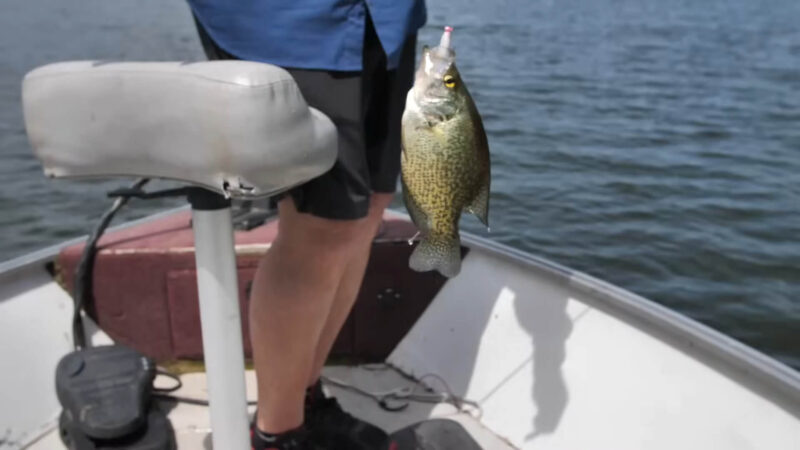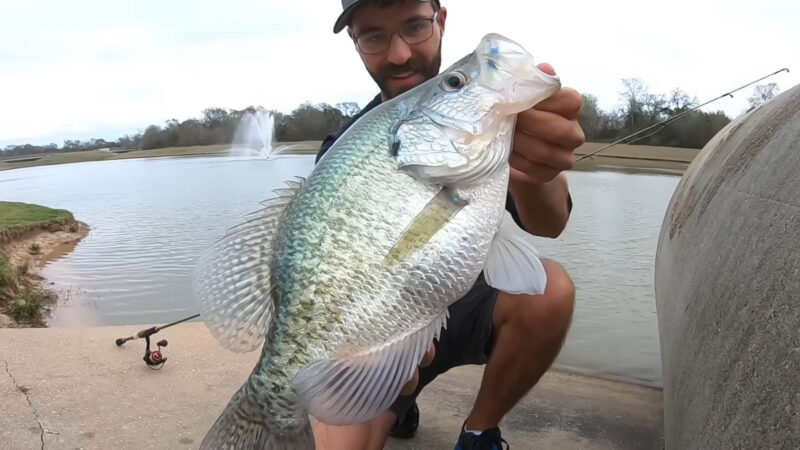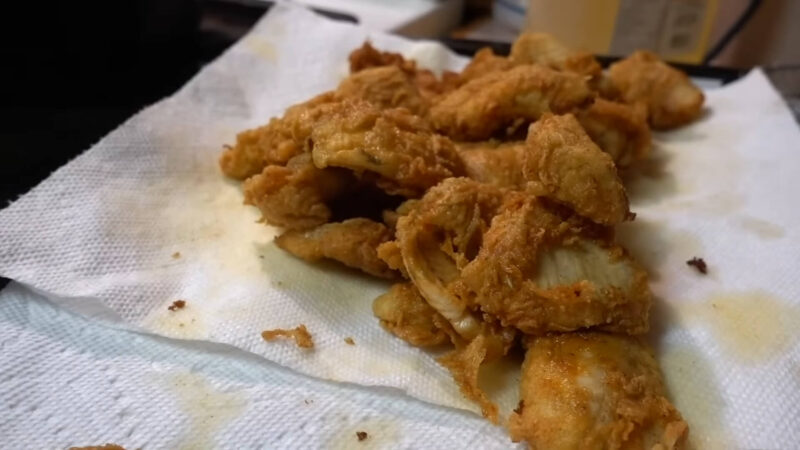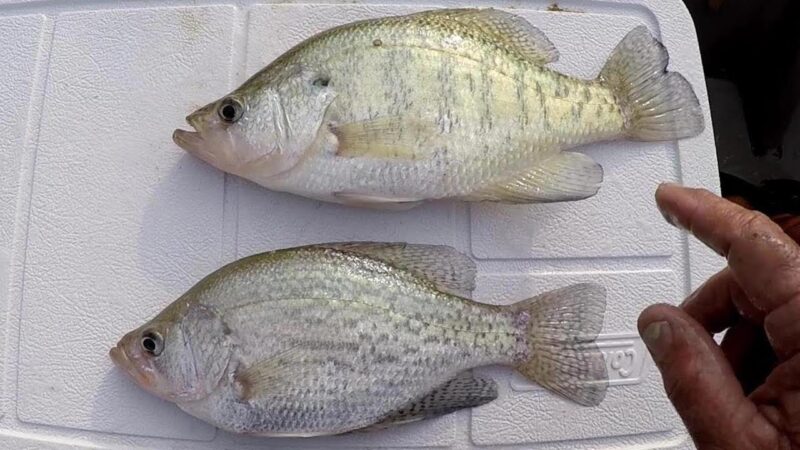When you’re out fishing for crappie, knowing the difference between black and white crappie makes a real difference. Black crappies love clear water with thick vegetation, while white crappies prefer murkier spots like rivers or reservoirs. You can also tell them apart by their markings: black crappies have scattered dark spots, while white crappies have faint vertical bars.
If you know these basics, you’ll have an easier time finding and catching them. It also changes how you cook and enjoy them. Some anglers think white crappies taste slightly sweeter, while black crappies have a firmer texture. Once you know which crappie you’re dealing with, you can adjust where you fish and what methods to use for better results on the water.
An Overview
| Characteristic | Black Crappie | White Crappie |
|---|---|---|
| Body Markings | Scattered dark spots | Vertical bars or stripes |
| Dorsal Spines | 7-8 spines | 5-6 spines |
| Preferred Habitat | Clear, vegetative waters like lakes and reservoirs | Murkier waters such as rivers and larger reservoirs |
| Spawning Behavior | Spawns earlier, in clearer and shallower water | Spawns later, in murkier, deeper waters |
| Taste and Texture | Firmer, meatier texture | Slightly sweeter taste |
Key Differences in Markings and Fins
When you’re trying to tell black crappie from white crappie, knowing what to look for in their markings and fin spines can be a game-changer.
Black Crappie

Black crappies have a scattered pattern of dark spots over a lighter background, giving them a more camouflaged appearance. This pattern helps them blend in well in clear, vegetated waters where they like to hide out. A quick way to confirm you’re dealing with black crappie is to check its dorsal fin; black crappies generally have seven or eight spines.
These spines, along with the irregular spotting, make black crappies distinct in clear-water habitats.
White Crappie

White crappies are marked by vertical bars or stripes along their bodies, which look almost like faint rings. They’re usually a bit lighter in color than black crappies, but don’t rely on color alone, water conditions can affect this.
White crappies have five or six dorsal spines, making them distinguishable from black crappies if you’re counting. Their more streamlined patterns match their preference for murkier, open waters, like rivers and reservoirs.
Also, check out How to rig and fish a rooster tail.
Quick Spotting Guide
Black Crappie
- Irregular dark spots across the body
- 7–8 dorsal spines
- Found in clear, vegetated waters
White Crappie
- Vertical bars or stripes
- 5–6 dorsal spines
- Found in murky, open waters like rivers and reservoirs
Where They Live
The spots you’ll find each type of crappie hanging out aren’t random. Knowing where to fish for them based on these traits can save you a lot of time.
Black Crappie Habitat
Black crappies thrive in clearer water with plenty of vegetation. They’re typically found in lakes, ponds, and reservoirs that have sand or gravel bottoms with lots of cover like weed beds, submerged logs, or branches. Their preference for these conditions helps them stay hidden and ambush their prey.
White Crappie Habitat
White crappies can tolerate murkier water and tend to hang out in rivers, large reservoirs, and other bodies of water where visibility might be lower. They prefer areas with some form of structure, such as sunken wood or rocks, but don’t require the thick vegetation black crappies do. They’re more common in waters with slight currents or less clarity, adapting well to the different conditions.
Black Crappie Spawning Habits
- Timing: Early spring, starting around 60°F.
- Location: Prefers shallow, clear water close to shore.
- Nesting: Males dig small beds in sandy or gravelly spots and guard the eggs until they hatch.
- Why Clear Water: Allows light penetration for the eggs, offering better conditions for survival
White Crappie Spawning Habits
- Timing: Slightly later than black crappie, around 65°F.
- Location: Can spawn in both murky and clearer waters, often near woody cover or brush piles.
- Nesting: Uses shallow, murkier areas that provide natural cover.
- Flexibility in Water Clarity: Adaptability to cloudier water means more options for spawning locations
Taste and Texture Differences

When it comes to eating crappie, both black and white crappies have a reputation for being tasty, but each has its own qualities that some anglers notice.
- Black Crappie: Known for its firmer, meatier texture, black crappies are often described as having slightly denser flesh. This firmer texture works well for a variety of cooking methods, especially frying, where it holds up nicely and doesn’t fall apart.
- White Crappie: Often considered a bit sweeter, white crappie has a lighter, flakier texture that some anglers prefer. This makes them ideal for pan-frying or baking, where their delicate flesh can shine. Some even say that the difference in taste comes down to the different environments each crappie lives in, with white crappie having a diet more focused on minnows and small fish, which can contribute to the flavor.
Additional Tips
For Black Crappie
- Use Smaller Baits: Black crappies often feed on smaller invertebrates and zooplankton. Tiny jigs or live baits like small minnows work well.
- Fish Near Vegetation: Look for areas with dense vegetation, submerged logs, or brush piles where black crappies feel secure. Try casting around weed beds or drop-offs with lots of plant life.
- Best Time: Early morning or late afternoon, especially in clear water, when they’re actively feeding.
For White Crappie
- Go for Larger Baits: White crappies feed on small fish like minnows, so using slightly larger baits can attract them. Jigs, spinnerbaits, or minnows work well.
- Target Murky Water and Open Areas: White crappies aren’t as picky about clarity, so rivers, reservoirs, or any spot with murkier water can be good. They often hang around wood structures, so cast near stumps, fallen trees, or docks.
- Prime Time: White crappies tend to be more active in low light, so early mornings or evenings are ideal, but they’re also more adaptable to daytime fishing in murkier waters.
The Biggest Catches Ever
Every crappie angler has likely heard about record-breaking catches that seem almost mythical. Black and white crappies both hold impressive records that add excitement to the fishing experience, inspiring anglers to chase their own “big one.”
- Black Crappie Record: The biggest black crappie ever caught weighed in at 5 pounds 7 ounces, landed by Jam Ferguson in Tennessee in 2018. This fish shattered previous records and remains the all-tackle world record for black crappie.
- White Crappie Record: The white crappie record, an impressive 5 pounds 3 ounces, has stood the test of time. Caught by Fred Bright in Mississippi back in 1957, it’s a record with serious staying power, and no white crappie has come close since.
FAQs
What’s the best bait for crappie fishing?
The best bait often depends on the crappie type and water conditions. For black crappies, small minnows, worms, or tiny jigs work well in clear, vegetated waters. White crappies go for slightly larger minnows and small fish, so try jigs or spinners if you’re in murkier, open waters.
When is crappie fishing season?
Crappie fishing peaks in spring when both black and white crappies come to shallower waters to spawn. However, you can catch them year-round, with summer and winter being better for deep-water fishing.
How can I find crappie without fish finders?
To find crappie without electronics, look for spots with natural cover like submerged trees, weed beds, or rocky structures. In spring, try the shallows close to shore. In hotter months, deeper areas near cover are your best bet.
Are crappies good to eat?
Yes, both black and white crappies are popular for their mild, flaky white meat. Black crappies have a firmer texture, while white crappies are slightly sweeter, which can affect how you cook them. Most anglers prefer frying or pan-searing crappie fillets.
Do crappies get active at night?
Yes, crappies can be active at night, especially around a full moon or in clear waters. Night fishing can be productive if you use lighted bobbers or fish near submerged lights, as crappies are drawn to light sources.
Last Words
Crappie fishing brings together everything anglers love about the sport: the thrill of the chase, the satisfaction of a well-fought catch, and a good meal at the end of the day.
With this knowledge, you’re set up to take on both types of crappie, make the most of their seasonal habits, and bring home a catch worth sharing. Black and White Crappie insights make each trip more rewarding.

